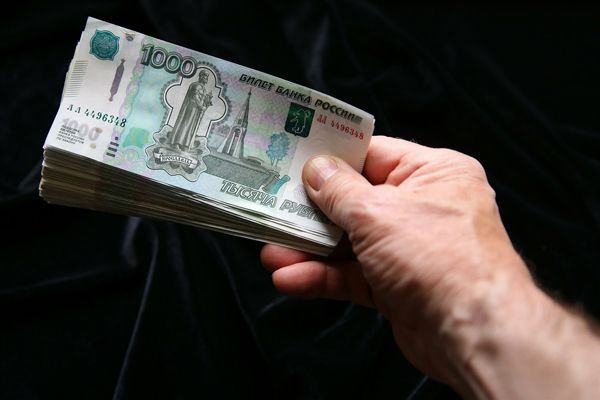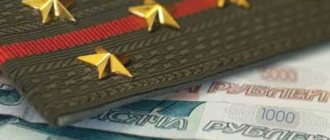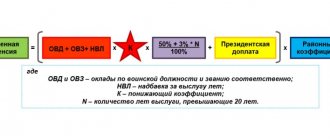From 2020, in connection with the increase in the retirement age in Russia, the traditional procedure for indexing pensions will be changed - now they will increase annually from January 1 at a rate higher than inflation (that is, faster than the rise in prices for consumer goods and services). Now the Government’s guideline when carrying out indexations will be to increase the average size of pensions by 1,000 rubles annually. Since in 2020 the average pension in Russia is 14,414 rubles, this increase from January 1 will result from indexation by 7.05% (for comparison: inflation in 2020 is projected at 3-4%).
Indexation of pensions from January 1, 2020 by 7.05% will ensure an increase in the average pension in Russia by 1000 rubles. Thanks to this, the annual income of the average Russian pensioner will increase by 12,000 rubles.
However, unfortunately, not everyone will receive one thousand rubles added to their pension in 2020 - such an increase will only affect non-working pensioners. For working citizens, the indexation of pension payments has been suspended since 2020, and the Government does not intend to change this approach in the coming years - the “freezing” of payments for them will continue in the future.
What does an increase in pension of 1 thousand rubles mean?
First of all, it should be noted that the amount of 1000 rubles declared by the Government is a conditional value. It is directly applicable only to the average pension in Russia (in 2020 it is 14,414 rubles). But in fact, the size of the increase, if we count it in rubles, will be different for all pensioners (the larger the pension, the greater the increase, but on average in the country it will be 1 thousand).
In fact, we are talking about the same indexation of the insurance (labor) pension that Russian pensioners until 2020 received annually from February 1 - the only difference is its size. If previously, when determining the size of the increase, the guideline for the Government was last year’s level of actual inflation, now, thanks to a significant decrease in inflation in the country, it is possible to increase pensions at a higher rate (that is, above the rate of inflation).
As a guideline, starting from 2020, the Government has determined an increase in the average size of pensions in Russia by 1000 rubles (for comparison: in previous years, inflation did not increase by an average of 500 rubles annually, i.e. twice as slow). Thanks to this, starting from 2019, the income of the average Russian pensioner will increase by 1,000 per month or 12,000 rubles. in year. The Government expects that with the help of such measures, by 2024 the average pension in Russia will increase from 14 to 20 thousand rubles.
However, it must be added that starting from 2020, not everyone will receive an increase of one thousand - only non-working pensioners will receive an increase. Working citizens, due to indexation “frozen” since 2016, will not be able to receive an increased amount of payments as long as they continue to work. However, for them, all missed indexations (including in an increased amount from 2020) will be taken into account only after dismissal.
Why do retirees quit for a raise?
Indexation of pensions concerns only non-working pensioners for whom no one pays contributions. Moreover, the indexation system is designed in such a way that when a working pensioner resigns, his pension is indexed taking into account all the interest that has accumulated. This does not mean that he will be paid all the increases in rubles: his next pension will be increased by all the percentages that were not taken into account earlier due to work.
For this reason, some pensioners specifically terminate their employment contracts and then sign them again. Because since the state has come up with a strange scheme to save money on indexation, it makes sense to take the maximum from it using legal methods.
If you decide to do this, discuss it with your employer to avoid losing your job. It may turn out that the director will only be happy with the application from the pensioner and will use this situation to hire a younger employee.
During the time when a pensioner works, his pension is not increased by a fixed indexation percentage, like a non-working person. But if he quits, he will become unemployed. And then the pension fund will recalculate the pension, taking into account all the indexations that the pensioner missed during his work.
For example, Nina Ivanovna quit her job in August 2020. Over the five years of work after the pension was granted, she accumulated several indexations - for example, for a total amount of 3,000 rubles. From September 1, Nina Ivanovna’s pension, taking into account increases, will be 17,200 rubles. But she won't get it right away. A pension, taking into account indexations, will be assigned when the pension fund receives information about dismissal from the employer.
An increase in pension by 1000 rubles - per year or per month?
The fact that the income of pensioners in 2020 will be increased by 1,000 per month or 12,000 rubles per year was first detailed on June 16, 2020 by Deputy Prime Minister for Social Affairs Tatyana Golikova at a meeting of the Russian Tripartite Commission for the Regulation of Social and Labor Relations, in during which the Government's proposed bill on raising the retirement age was discussed.
Unfortunately, this statement turned out to be not entirely clear to the population of the country, and even confused many. The announced scheme was not obvious, and many clarifying questions arose - in particular, did they really mean a monthly increase in pensions by 1000 rubles? from 2019, what in a year will allow you to increase its size by 12,000 rubles?
In fact, this statement meant that the average pension in 2020 would increase by 1 thousand (from 14.4 to 15.4 thousand rubles), that is, by 7.05%, and only for non-working pensioners. Accordingly, in annual terms, the income of the average non-working pensioner in 2020 will increase by 12 thousand rubles. But the increase itself will occur, as with regular indexation - only once a year (from January 1). Further, pensions will be paid at an increased rate throughout the year until the next indexation.
The corresponding increase will be made annually. Thus, every year from January 1, the average pension in Russia will increase by 1,000 rubles. more than a year earlier. That is, if during 2018 the average pensioner was paid 14 thousand rubles, then in 2020 he will receive 15 thousand monthly (i.e. 1 thousand more). And thus the Government plans to index the incomes of pensioners until at least 2024, so in 6 years they will increase by 6 thousand rubles (from 14 to 20 thousand).
Why the increase in pensions from January 1 may be less than 1000 rubles
The thousand-ruble increase was calculated based on the average amount of insurance pension payments in 2020 - 14,414 rubles. If they are indexed by 7.05%, the increase will be about a thousand rubles. The increase in the pension amount for each specific case may be higher or lower than the specified value, and is determined by the current amount of security:
- For 12,000 rubles, the increase in pension will be 846 rubles.
- For 13,000 rub. – 916.5 rub.
- For 14,000 rub. – 987 rub.
- For 15,000 rub. – 1057.5 rub.
- For 20,000 rub. – 1410 rub.
- For 25,000 rub. – 1762 rub.
A thousand-ruble increase will total increase pension payments for the year by 12,000 rubles compared to the previous year.
The rate of 7.05% with which labor pensions are increased is almost twice as high as the inflation forecast of 3-4%. The government explains the high size of the increase by optimizing Pension Fund expenses due to the fact that the retirement age in Russia is increasing.
- Group 2 disability pension - calculation procedure, package of documents for registration and deadlines for receipt
- Exercises for potency at home for men - breathing, strength and restorative complexes
- Honey cake
At the same time, according to the Russian Ministry of Finance, due to the increase in VAT from 18% to 20%, inflation may reach 4.5%. In relation to a 7.05 percent increase in the average pension by one thousand rubles means that:
- RUB 644.81 will compensate for price increases due to inflation;
- RUB 355.19 (2.5%) will be the real amount of the additional increase.
A separate case of increased payments is an increased old-age pension. It is determined when the recipient reaches 80 years of age. In this case, the pensioner is assigned an age-related increase in the basic part in the amount of 100% of the available amount of security (that is, the amount of the fixed payment is doubled).
Indexation of social payments
The recalculation of state benefits of this type in 2020 will occur on February 1 by 3.1%. Such subsidies include:
- Set of social services (NSS). It includes the provision of sanatorium-resort treatment and medications. The benefit has the same amount for all categories of pensioners - 1075.19 rubles. for 2019, and 1108.60 after the increase. NSO can be capitalized and received as a cash equivalent.
- Monthly cash payment (MCV). Assigned to pensioners of preferential categories (persons with disabilities, liquidators of man-made disasters, etc.). Varies in size depending on the type of payment. Thus, combat veterans are entitled to 2850.26 rubles in 2019. After indexation by 3.1%, the amount of security will be 2947.17 rubles (this is with capitalization of the NSO, but if the social package is obtained in the form of services, then the EDV is equal to 2947.17 - 1108.60 rubles = 1838.57 rubles).
- Funeral benefit. It is paid from the Pension Fund budget to the person who incurred the costs of the funeral of the pensioner - this can be not only relatives, but also friends, neighbors, and work colleagues. In 2020, this subsidy amounted to 5,701.31 rubles; after the February indexation of 2020, its size will become 5,878.05 rubles.
Increase in pensions for civil servants
For government employees who have retired due to length of service, pension indexation in 2020 will occur on April 1. It will be increased by 2.4%. In order for the increase to be equal to 1,000 rubles, it is necessary to have current payments of at least 41,666.66 rubles, therefore, for most civil servants on well-deserved retirement, the increase will be less.
The size of the social pension in 2020
The period and amount of indexation of pensions of this type coincides with the increase in payments to civil servants and is carried out in a similar amount (that is, on April 1 by 2.4%). These payments are provided to persons who are not entitled to other types of security. Social pensions are:
- Due to disability. Prescribed to persons with diagnosed disabilities who do not have insurance coverage.
- For the loss of a breadwinner. Paid to minor children (and other disabled relatives) of the deceased person, in the absence of his insurance experience.
- Due to old age. This requires reaching retirement age. The first stage of its increase will begin in 2020, so the increase on January 1, 2019 will be given to persons whose retirement was in the same order: 55 years for women and 60 for men.
The last category includes citizens who have reached the established age, but have not accumulated the required work experience and have not accumulated the required number of pension points.
- Eggplants in a slow cooker
- West Highland White Terrier - description and character of the dog breed, care and raising of puppies
- New laws that will come into force in June
The pension for such persons before the April increase 2020 will be 5,180.24 rubles, after - 5,304.57 rubles.
Regardless of the type of pension payments, the recipient is given a special bonus. It is prescribed if the amount of security is less than the pensioner’s subsistence level (PLS). This value can be considered analogous to the minimum pension; it is set at the regional level and varies depending on the recipient’s place of residence:
- In 2020, the cost of living for a Muscovite pensioner is 11,816 rubles, in 2020 it will be increased by 2.53% and will be 12,115 rubles.
- In the Moscow region there will be a 4% increase in these payments from 9,524 rubles. up to 9,908 rub.
- In St. Petersburg and the Leningrad region - from 8,726 rubles. up to 8,846 rub. (growth by 1.4%).
To calculate the total amount of security for a particular person, the following income options are taken into account:
- All types of pension payments assigned to a given person.
- The financial equivalent of a set of social services.
- Monthly cash payment.
- Other additional financial support.
- Any options for social assistance.

If the sum of all these indicators is less than the regional value of PMP, then the pensioner has the right to a social increase. For example, if after indexation in 2020 the amount of payments from a Moscow pensioner is 10,000 rubles, then he is entitled to an additional payment to his pension up to the size of the PMP - 2,115 rubles.
Who is scheduled to receive a 1,000 ruble increase in their pension in 2020? per month?
The “increase by 1,000 rubles” announced by the Government will be implemented in the form of indexation, and not through an increase in a fixed amount for everyone. Therefore, the amount of the additional payment is determined not by a specific amount for absolutely all citizens, but as a percentage of the pension already paid to them.
In practice this also means the following:
- Pensioners who receive payments below the average (less than 14,414 rubles) will receive an increase of less than 1,000 rubles. And vice versa - pensioners with high incomes will receive a higher increase (more than 1000 if their pension exceeds 14414 in 2020).
- Due to the fact that since January 2020 the law on the suspension of indexation for working pensioners has been in force, the planned increase in pensions in 2020 by 1000 will not affect them again.
An increase in pensions by 1,000 rubles from January 1, 2020 will be made only to non-working pensioners in the form of indexation by 7.05% (this is higher than inflation, which is expected to be 3-4% in 2020). With an average pension amount (RUB 14,414 in 2020), this provides an average increase of 1 thousand.
Pensioners who continue to work (and there were about 9 million of them as of May 1, 2020) can receive a cash increase only as a result of the annual recalculation of pensions in August, which has a number of features:
- Made for the purpose of accounting for insurance premiums that are paid for a pensioner by his employer to the pension insurance system;
- The increase is determined based on the amount of accumulated points, which are taken into account in an amount of no more than 3.
- This additional payment will be significantly less than the 1,000 rubles promised for non-working citizens. The maximum that a working citizen can count on is an additional payment of 244.47 rubles. to the current pension amount.
It should also be noted that all missed indexations (including annual increases by an average of 1000) will be taken into account for working citizens when determining the final amount of pension benefits after their dismissal (cessation of employment).
Who won't get 1000 rubles?
Now we remember the promise of our officials to increase pensions by 1000 rubles annually. Will they keep that promise this time?
That is, if your pension is less than 15.4 thousand, they will increase you less.
It turns out as always: “the rich get richer, the poor get poorer.”
If your pension is 10,000 rubles (which is quite typical for most of Russia), then the increase will be only 660 rubles.
And now another trick for those whose pension is less than the subsistence level in your region. You can see the cost of living in your region on the page: Data on the cost of living by region (see the table “for pensioners”).
The state cannot pay a pension below the subsistence level, and pays extra to those who have exactly this situation.
Such pensioners will also have their pension indexed, but 6.6% will only be added to the amount of your pension and will not increase the additional payment.
This is the arithmetic.
An old-age pension may be less than the regional subsistence minimum for a pensioner. For example, a man worked unofficially all his life and accumulated only minimal experience and points. By the age of 60, he was awarded a pension of 8,500 R. And the cost of living in the region is 10 thousand rubles.
Such pensioners are paid an additional amount that is not enough to reach the subsistence level in the region. Despite the fact that the earned pension is 8,500 R, the man will receive 10 thousand: the budget will add 1,500 R to him.
8500 RUR 1500 RUR 8500 RUR × 6.6% = 10,561 RUR
When the pension is less than the subsistence minimum, indexation does not concern the full amount of the payment, but only the actually accrued old-age pension, taking into account length of service and points. Therefore, for some pensioners, their full pension, taking into account additional payments, will increase not by 6.6%, but, for example, by 5%.
Everything you wanted to know about pensions
Who will get a raise and how to get it - in our free newsletter along with other materials about money
Deputy Prime Minister Tatyana Golikova announced an increase in pensions in the amount of 12,000 rubles per year. In fact, the increase of 12,000 rubles per year voiced by Tatyana Golikova means that the total annual income of the average non-working pensioner will increase by this amount, and not the monthly pension by the end of the year. Below is the pension calculation.
Of course, citizens should treat the words of an official of such a high rank with understanding. After all, she headed the Accounts Chamber and was the Minister of Health. True, some citizens, including pensioners, have not experienced improvements in this area. However, most have now forgotten about this. And it’s not about healthcare.
An increase of a thousand to the pensions of all pensioners was announced at a time when the overwhelming majority of citizens were indignant at the pension reform being pushed by the government and United Russia, supported by the president. The protests were attended not only by those who are “like walking to Moscow” before retirement, but also by pensioners and people of pre-retirement age. It was precisely for them that twelve thousand rubles per year were announced.

Time passed, and a law providing for raising the retirement age for men to 65 and for women to 60 was adopted. They did not allow a referendum to be held on this topic. Although the public did not calm down, the protests seemed to have died down. And then the authorities decided to reach an agreement on the thousandth increase in pension.
How will pensioners receive an annual 12,000 ruble increase?
Starting from 2020, the Government plans to change the standard indexation scheme and increase pensions from January 1, 2020. Let us recall that the traditional pension indexation plan was carried out according to the following scheme:
In past years, insurance pensions increased from February 1 depending on the level of inflation in the past year. The inflation rate in 2018 is projected to be within 4%, so under the old scheme in 2019, pension benefits would have been increased by an average of 570 rubles. (this is the ruble equivalent of indexation for inflation in 2019).
The indexation scheme proposed by the Government from 2020 should ensure an increase in the income of pensioners not only by the amount of inflation, but also in real terms. Thanks to this, the average amount of payments to Russians will exceed 20 thousand by 2024. Taking into account the already published draft budget of the Pension Fund for 2019-2021, pension increases will be carried out according to the following scheme (see table below):
| Year | 2018 | 2019 | 2020 | 2021 |
| Indexation, % | by inflation * | on average 1000 rubles per year | ||
| 3,7 | 7,05 | 6,6 | 6,3 | |
| Average pension size, rub. | 14414 | 15430 | 16448 | 17484 |
Note: * - in fact, in 2020, insurance pensions were also indexed above inflation and one month earlier (from January 1 by 3.7% with last year’s inflation rate of 2.5%). This required the adoption of an additional law dated December 28, 2017 No. 420-FZ.
It is easy to see that the growth of the real size of the pension with an annual increase of 1 thousand will decrease annually due to annual inflation (the real purchasing power of these 1000 rubles will decrease year by year). The real growth of social payments is determined by the difference between the planned indexation percentage and the CPI level for the previous year. The Ministry of Economic Development's inflation forecast is presented in the table:
| Year | 2018 | 2019 | 2020 | 2021 |
| Inflation rate, % (forecast) | 3,1 | 4,3 | 3,8 | 4,0 |
This means that in real terms the average pension in 2019 will increase by only 7.05 - 3.1 = 3.95%. In 2021, the real size of this increase will be even smaller: 6.3 – 4.0 = 2.3%.
How the size of the social pension will increase
The head of the Pension Fund also announced an increase in social pensions for state pensions, which are received by disabled people and citizens who do not have enough experience and points to receive an insurance pension. Anton Drozdov said:
Currently, the size of the social pension is 9,764 rubles. After the increase, it is 10,320 rubles, which is about 5% higher than the cost of living of a pensioner.
Thus, social pensions will also be indexed above the level of planned inflation. True, their recipients will receive the increase later - from 04/01/2020, and not from 01/01/2020, like recipients of an insurance pension. Previously, it was said that social payments would be indexed by only 3.8%, but in the event of higher inflation, the authorities promised to consider increasing this index. At the same time, a new indexation methodology will be used - not only the basic pension, but also the social supplement to it. That is, all recipients of social pensions will actually receive an increase, and not just those who do not receive additional payments from the regional or federal budget.
If a pensioner goes back to work
For example, after her dismissal, Nina Ivanovna’s pension was increased by 3,000 rubles and now she receives 17,200 rubles. In January 2020, Nina Ivanovna will receive an increase in her pension due to annual indexation - as a non-working pensioner. And he will already receive 18,300 rubles a month. But in February 2020, Nina Ivanovna will decide to get a job again. She has already received indexation for all years, including 2020. Now she will always receive 18,300 rubles, even after going to work.
In 2021, her pension will no longer be indexed: she will only be recalculated on August 1, as a working pensioner. Unless, of course, Nina Ivanovna decides to quit again by the end of the year for the sake of indexation - and here’s a life hack: dismissal for the sake of a raise and subsequent employment. According to the law, it is impossible to take away a raise due to the fact that a pensioner has become a working person again.









